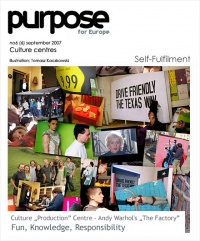
Analysis
Centre for culture "production" - "The Factory" Andy Warchola
However, also in this area the last two decades have witnessed certain changes in this respect, changes, the traces of which could have been seen much earlier in the world. In liberal democracy countries, where art was commercialised, alternatives for the traditionally understood culture centres appeared as early as the 1960s. Official institutions that dealt with art met with wide opposition. Many artists representing various art fields showed their works outside official circulation, art works were in independent circulation. That strategy was related to the alternative movements popularised by the left-leaning intelligentsia and youth. It resulted from the conviction that the power of capitalism was exhausted and it was necessary to replace it in all areas of life, in culture too, by socialism. It was also supposed to show that human activities, such as the production of works of art cannot be expressed in money terms.
This kind of attitude prevailed in Europe, while in the United States nobody even though about questioning the importance of money. On the contrary, artists saw its power and wanted to use it for their own benefit. Andy Warhol said: “Earning money is easy, working is easy, but doing a good business is no mean feat”. That’s why culture centres established in the States were of a completely different character than those established in Europe. I would like to write about one of them, the centre whose specificity raised controversy and was a subject for argument. I mean Andy Warhol’s ‘The Factory’. That’s how his studio on the fifth floor at 231 East47th Street in Manhattan, New York was called. It was a peculiar studio though, which became a culture centre de facto. Its name itself was equivocal, as was everything that was going on there: on the one hand, the place had housed a hat factory before, on the other – the name referred to the “production” of works of art that took place there. Another reference was the interior designed by Billy Linicha, also called Billy Name, at the beginning of 1964. John Cale recalled: “The name ‘The Factory’ didn’t come from nowhere. It is there that the production line of silk screen was located. One person was making silk screen, and some other was taking screen shots. Something new every day”.
It seems that it was Andy Warhol’s idea that decided about the character of the place – he treated art as an element of the American way of life. He used to say: “What I like is that in America the wealthiest consumers basically buy the same things as the poor ones. You are sitting in front of a TV-set, drinking Coca Cola, and you know that the President drinks Coke, Liz Taylor drinks Coke, and you are thinking that you can drink Coke too”. This should be the case with art as well, art should be accessible to every American consumer. That’s why ‘The Factory’ produced not only works of art, but also music and films. ‘Events’ were organized, attended by people of the weirdest reputation, very often rich, but bored with life, addicted to alcohol or drugs. Warholcould guarantee each of them ’15-minute fame’, and although the fame was very illusory, many individuals were even ready to work hard. According to some people, Warhol whose ambition was to produce as much as in the production line, used that readiness of porno stars, drag queens, drug addicts, musicians, freethinkers who came to his studio. Those ‘art workers’, whom he called ‘Warhol’s superstars’, helped him to paint pictures, starred in his films and created the scandalous atmosphere which made the legend of The Factory.
The borderline character of this enterprise had to cause problems which did appear occasionally. Such concentration of people who had various problems with their own identity, full of complexes, emotionally unstable, led to sinister events every now and then. The most dangerous one was the attempt to kill Andy Warhol on June 3rd, 1968. The attempt on her idol’s life had been made by Valeria Solana who allegedly said that she had done it because Warhol had had too much control over her life. The event showed that complete, unrestricted freedom to do anything most often leads to a pitiful effect. Since that time Warhol started to select people who came to his studio more carefully, and the most spectacular period in ‘The Factory’ became history and legend.
By presenting such an extreme example as ‘The Factory’ I wanted to demonstrate how widely and differently the notion of an art centre can be understood. It doesn’t mean that Warhol’s pattern should be followed. However, it enables us to confront the activities of traditional art centres with artistic experiments of the Pop-art legend, and to draw our own conclusions. This example also shows that culture centres can be not only of a public but of a commercial character too. It seems that in Poland there is little chance of the latter to succeed. Maybe it’s just as well?
Check the archive

nr 36 September 2007
theme of the issue:
CULTURE CENTRES
< spis treści
Article
From the Editors
Interview
"new place for art" - interview with Aneta Dalbiak from Museum of Art in Łódź Promotion Department
Presentation
a-i-r
Analysis
Centre for culture "production" - "The Factory" Andy Warchola - Artur Zaguła
Kariera w kulturze
W różnorodności jest siła - interview with Grzegorz Lewandowski
Culture Industries
The 24 Hour Museum - conversation with Jane Finnis





